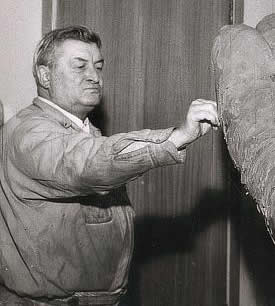Wäinö Valdemar Aaltonen (Wäinö Valdemar Aaltonen)

Sculptor. As a young man he studied painting for five years at the School of Drawing of the Turku Art Association in Turku, Findland, but as a sculptor he was largely self-taught. Working in bronze and stone, occasionally incorporating glass, he developed a naturalistic style, with some influence of Cubism, which he had encountered during a journey in Italy in 1923. He made his name as a sculptor of war memorials, his nationalistic subjects and heroic monumental figures being seen as particularly apposite whilst the modern Republic of Finland emerged during the First World War. The high value placed on his nationalist figures is shown by the installation of Aaltonen’s sculptures in the Finnish Houses of Parliament in the 1930s. A cast (one of five) of one of his most famous works, the statue of Finnish athlete and nine-time Olympic gold medalist Paavo Nurmi (1925), is positioned outside the Helsinki Olympic Stadium. The runner is shown at full stride, only the toes of his right foot touching the ground. Aaltonen’s bronze bust of composer Jean Sibelius (1928) is also well-known. The Wäinö Aaltonen Museum of Modern Art in Turku, Finland, designed by Aaltonen’s son Matti Aaltonen and wife Irma Aaltonen, with the artist’s collaboration, opened in 1967. It’s permanent collections include many works by Aaltonen, and others reflecting a focus on the art of the Turku region and three-dimensional art. The Museum’s Library was endowed with 8,000 volumes from Aaltonen’s personal collection, and the Archives include many of his photographs and early works and sketches. (bio by: Sheilia W.)
Born
- March, 08, 1894
- Finland
Died
- May, 05, 1966
- Finland
Cemetery
- Saint Mary's Churchyard
- Finland

